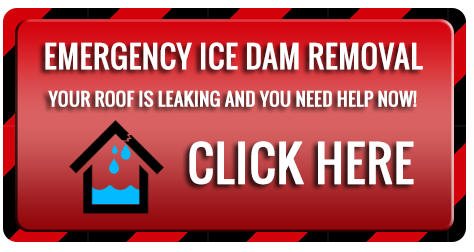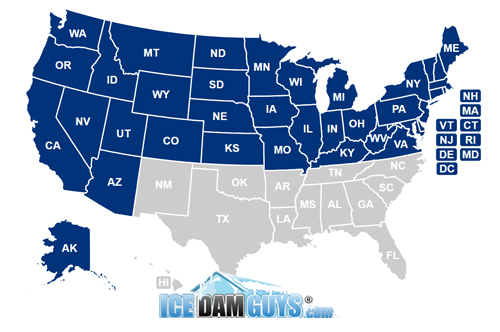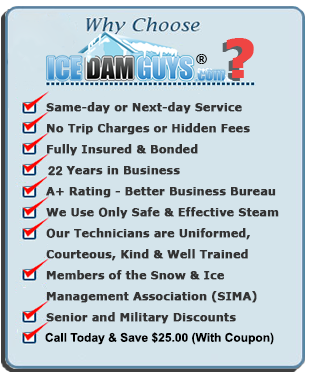10 Bad Ice Dam Removal Methods
Call us at 1-800-423-3267 if you have an ice dam on your roof and live anywhere in the US, including in hard-hit Alaska. We are properly licensed, bonded, and insured, and are the top-rated ice dam removal company in the US. You can end the leaks with a phone call to Ice Dam Guys®.
Never underestimate the lengths people will go to save a buck, or the lengths others will go to make a buck. When someone really wants to avoid hiring an ice dam removal company, or a company is desperate for customers, strange and bad things often go down.
Below are 10 ice dam removal methods we suggest you avoid – because they’re ineffective, dangerous, or both.
Bad ice dam removal method #1: heat cables
Some people try to use heat cables to prevent ice dams from forming in the first place. In our experience they aren’t very effective at that, and they’re even less effective at removing ice dams that have already formed. But when a self-proclaimed “professional” claims to solve all your ice dam problems for years to come, and for a fraction of the price it will cost you to have ice dams removed, it’s hard to say no.
The theory is that you can lay the heat cables on top of an ice dam and slowly melt channels into the ice, releasing dammed-up water. The trouble is the cables aren’t hot enough to remove an existing ice dam, so the ice dam just keeps growing right over of your heat cables. So you end up with even more water on your roof – and perhaps eventually in your house – than you’d have if you’d left the ice dam alone. That’s if the cables melt the ice at all, which they may not.
The same is true of “snow melt mat” and “heated sheet-metal panels” and similar products. Those are the same bad candy in a different wrapper.
Although we almost never recommend heat-cables, heated-panels, etc. as a way to prevent ice dams, to install them after ice dams have formed is a an absolute sham and waste of time and money.
Bad ice dam removal method #2: salt pucks or salt bricks
If you want round little holes in the snow & ice on your roof, use salt pucks.
If you want rectangular holes, use salt bricks.
Either the pucks or the brick will work if you want a hole in your wallet.
If you want to melt your ice dams, don’t use anything with salt (or chemicals). The holes will simply fill with snow, and that snow will melt from the salt that’s resting below it, refreeze, and create an even bigger salty melty mess on your roof. Plus, if water was leaking into your home, now you’ll have salty or chemical-laced water seeping into various cracks in your home.
Don’t put anything on your home that you wouldn’t in your home.
Bad ice dam removal method #3: salt pantyhose
People seem to have a thing for pantyhose. The idea is to fill up stockings with salt and lay the stockings on your roof, perpendicular to your overhangs (and the ice dam). The hope is you’ll watch the ice dam disappear, or at least you’ll melt big fat channels in the ice dam and watch the dammed-up water break free from behind the ice dam with the glory and majesty of an Icelandic waterfall.
The main problem is that salt doesn’t melt ice quickly. Salt’s ability (or inability) to melt ice depends mostly on the temperature. Typically any ice melted by salt-filled pantyhose refreezes as soon as it’s trickled an inch or so away from the pantyhose. That’s another big mess on your roof. Also, if snow happens to pile up on the salt-filled pantyhose, the salt will quickly melt that snow into water, which adds to the dammed-up water behind your existing ice dam(s).
The other problem is the chemical makeup of the salt or ice-melt product you filled the hosiery with. Those products tend to contain corrosive chemicals, which can damage your home and property in a variety of ways. It’s not good for your shingles, driveway, lawn, or plants, and can cause major rusting of metal screws, nails, gutters, flashing, and so on.
Worst of all, if waters leaks into (or is already leaking into) your home, it will bring the salt and corrosive chemicals in with it, potentially adding to the rot and damage.
Bad ice dam removal method #4: pressure washers
It’s risky enough to use a pressure washer to remove mold, moss, and lichen during the warmer months. Although roofs are pressure-washed often in the summer months, it’s different. In the summertime you can see what you’re removing (moss, algae, etc.) as well as the substrate it’s attached to. In the winter that substrate (your shingles) is covered in a layer of ice. It’s hard not to damage a shingle when you can’t see it. It can be done safely with enough practice and trial and error. But we never recommend it.
A pressure washer can put 5+ gallons of water onto your roof every minute. The last thing you need on your already-leaking roof is more water (especially at a clip of 5 gallons a minute).
The water’s not as hot as you might think. A hot-water pressure washer typically only heats water to about 180 degrees. By the time that water travels through 100-200 feet of pressure washer hose lying on frozen earth, you’re working with lukewarm bath water at the nozzle. Even well-executed ice dam removal takes many hours. A drawn-out attempt at melting an ice dam with an under-heated pressure washer will take much longer, and for no good reason.
Also, at 2000 to 3000 PSI a pressure washer can cut a wooden two-by-four in half with ease, and it can slice through your shingles like they were Kobe beef. Though it’s possible a trained professional could safely remove ice dams from your roof using a pressure washer, in practice no professional would use such an instrument under normal circumstances. They’re too powerful in the wrong ways, and their output is not hot enough.
Bad ice dam removal method #5: sharp, pointy, or blunt objects
Hammers, sledge-hammers, pickaxes, axes, hatchets, saws, and wooly mammoth tusks are imprecise and dangerous. Even if you tap rather than whack, or you chip rather than stab, you will damage your roof. Because the ice is adhered to your shingles, the only questions are, how many protective granules you’ll strip off your shingles, and how many shingles you’ll rip off or wear down to wafer-thin tar paper.
The ways you can hurt your body and reputation are even more diverse and exciting. You’ll be the talk of the town and perhaps even a YouTube sensation.
Bad ice dam removal method #6: roof rakes
Roof rakes are great tools to remove snow from your roof before it can melt, refreeze, and form an ice dam. Roof rakes are great preventative tools.
But, as with any tool, people find creative ways to use it all wrong.
Some people use a roof rake as a kind of axe-like tool and hack at their ice dams like Paul Bunyan. The only things that a flimsy plastic or aluminum roof rake will take down is snow. Hacking at an ice dam will only bend or break your rake, or destroy your gutters or shingles. We see roof-rake-damaged shingles on the vast majority of the homes we visit. Whether that’s caused by improper roof raking technique, or by using a roof rake for ice dam removal, one never knows.
Some people use roof rakes to try to drag the ice off the roof. That won’t work. The ice is bonded to the shingles. It won’t come off without taking some shingles with it.
If you’ve got new snow falling onto an existing ice dam, raking the new snow can’t hurt. But that won’t help with the ice dam, particularly if it’s caused leaks. There’s still plenty of snow higher up the slope of the roof that will continue to melt and pool behind the existing dam.
Keeping the snow off of your roof by roof raking after every snowfall is the best way to avoid needing professional ice dam removal. If you neglected to do that, and now you’ve got ice dams causing a leak inside your home, you’ll need professional ice dam removal whether you like it or not. If cost is your concern, the alternative is to risk leaks and home repairs that you really won’t be able to afford. Once ice dams have formed, the time for roof-raking has passed.
Bad ice dam removal method #7: torches and other sources of flame
The other attempts at ice dam removal aren’t effective, but they’re not madness. What’s more Dostoevskian than taking fire to your home?
In case your reasoning is “It’s all frozen, so it can’t burn,” I’d like to remind you that your house is made of wood, and inform you that asphalt shingles are derived from petroleum.
We suppose a burning house is one way to melt an ice dam, but we can’t recommend it.
Bad ice dam removal method #8: chemicals
Same problem here as with the salt “solutions” (methods #2-3): what goes on your roof doesn’t stay on your roof. Like cat fur, it will get everywhere. It will end up all over your property, inside and out.
The other issue is no chemical can melt ice quickly enough not to create more pooling and leaking. If you can’t remove the ice dam in a matter of hours, you’ll just create more water (now chemically-laced water) with no place to go but inside your home. Don’t put any chemical on your roof that you wouldn’t be okay with finding in your attic, near wiring, in a wall cavity, soaked into your insulation, in your carpet, on your furniture, or in your cookware.
Bad ice dam removal method #9: any future “quick fix”
Any quick and cheap so-called ice dam solution will involve salt, chemicals, or a heating device. Those are ineffective or damaging in the ways I’ve already described.
Ice dams are created by great forces: Mother Nature + the pent-up heat of an entire home + Father Time. Even if the contents of a bucket or box could remove an ice dam, the job wouldn’t get done quickly enough to prevent or end the leaking. If a ice dam removal method sounds cheap and easy, it’s probably neither. It’s too good to be true.
Bad ice dam removal method #10: the monster membrane
This idea came from a meteorologist at The Weather Channel who grew up in Upstate New York. I’m torn as to whether his idea is bad or sheer brilliance. He installed an air bladder system along the overhangs of his roof. Imagine a forty-foot long, two-foot-wide water bottle with no water in it. He laid that rubber membrane along the overhang and waited for ice dams to develop. When they did, he filled the bladder with air. The expansion would break up the ice dams, causing them to slide right off because they froze to the bladder and not to the roof.
What I don’t know is how time-consuming and expensive that was. Also, even if it’s easy and inexpensive and ineffective, you probably don’t want a forty-foot whoopee cushion on your roof.
The only good way to remove ice dams: steam
The combination of steam and an experienced operator/professional is the only sure-fire way to get ice dams off of your roof without damaging your roof or the rest of your home. Our steamers create enough heat to melt ice, of course, but they don’t directly heat your roof. Nor do they apply any direct force to your roof, or introduce chemicals, or create a bigger mess.
Considering DIY ice dam removal? A decent (but not excellent) off-the-shelf steamer is about $4,000. But then you alone will be responsible for what happens to you and your home while you’re on the slippery ladder and/or the icy roof, and you still have to get up there in the dead of winter. Expensive and dangerous: the worst of both worlds. After you call a professional to remove the ice dam this winter, you’re crazy not to get your insulation fixed so that you don’t need to worry so much about ice dam removal next winter.
For most people, hiring a professional ice dam removal company, with its professional-grade steamers and experience in removing ice dams, is the least-bad option.






















